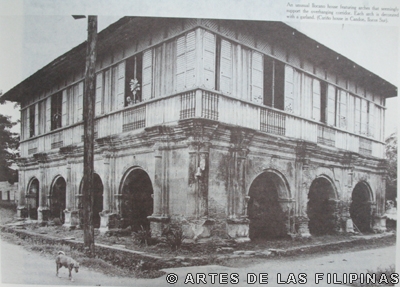

The bahay na bato or the Colonial Filipino house is a mixture of native Filipino, Spanish and Chinese influences. These houses are were usually owned by the rising upper-classes, otherwise known as the principalia and the ilustrados. The bahay na bato is a mixture of the original structure of the nipa hut mixed with stylistic elements from Europe and
The structure is typically raised or two-story. The main living area is on the upper level while the lower walls of the classic bahay na bato, the zaguan, was used to store the family carriage and processional cart in the old days. Today, however, it usually functions as an office, shop or the family's sari-sari store. The lower walls of the classic bahay na bato were usually done in stone but modest homes have wood walls for the second floor and the zaguan.
After colonizing the
The structure of the house symbolizes the native Filipinos’ fondness of confort. The architecture of the house was made in such a way as to take advantage of the cooling breezes. Large windows surrounded the upper floor with the window sashes, which commonly have capiz shell panes, can be opened wide or closed for privacy or in stormy weather. Vents above the windows, protected by the roof eaves, let air in even when it's raining. Small shuttered windows below the large windows, called ventanillas, are screened with balusters or grillwork and can be left opened when the large windows are closed such as at night.
The bahay na bato served as the model for townhouses from the 19th century until World War II and is considered the quintessential Filipino house. These houses today, to be found in good condition, are a rarity. There may be a number in Metro Manila, but rarely is there one in good condition. Most of these houses – houses with a rich history – are now dilapidated buildings, crooked and forgotten. There are some in the provinces which the locals preserve as a means for attracting tourists. Vigan, in Ilocos Sur, prides itself for having a street of stone houses which it has preserved throughout the years. The town of
No comments:
Post a Comment